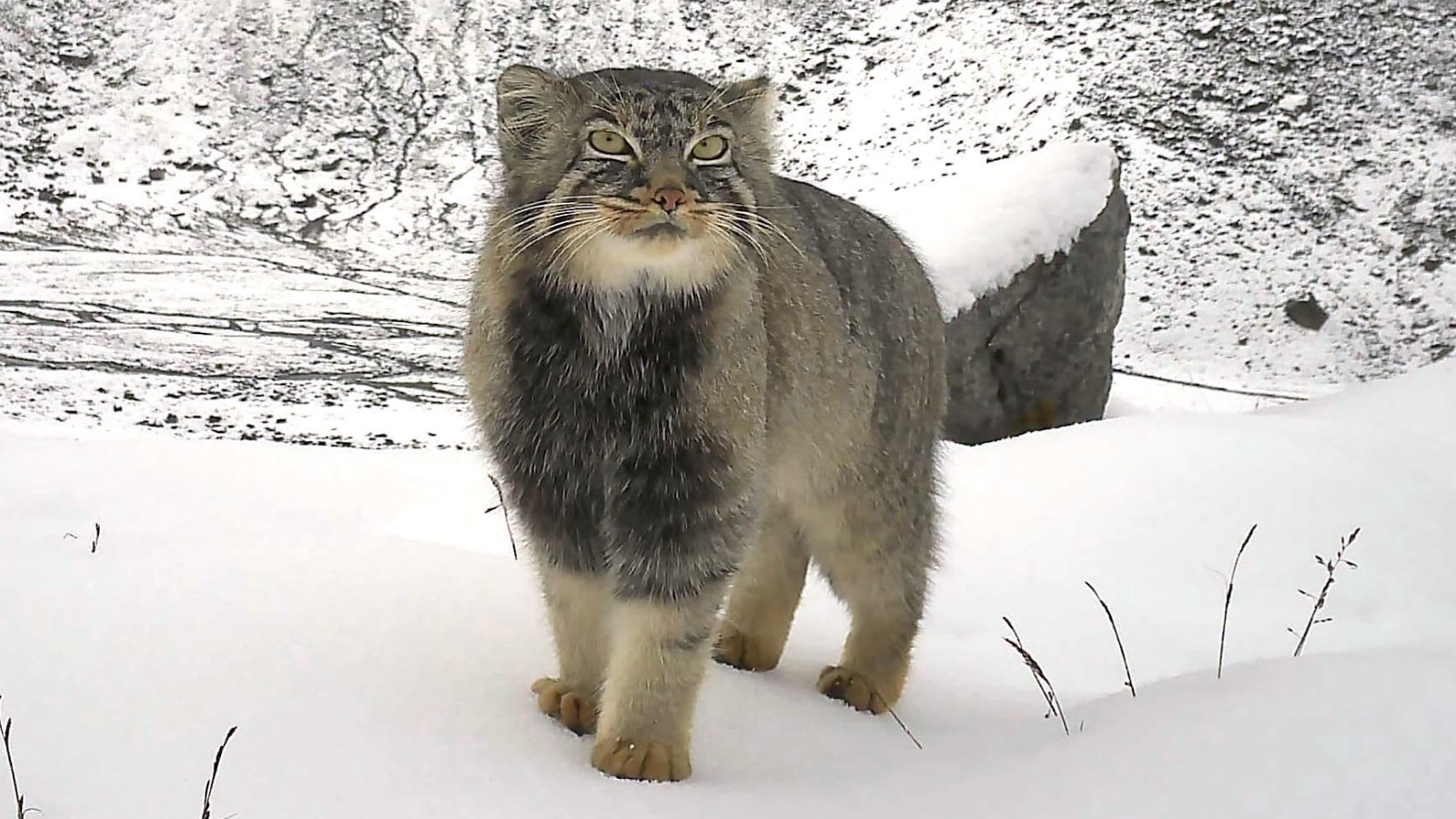Grumpy-looking Pallas’s cat photographed by camera trap in stunning photo from eastern Himalayas
By Lydia Smith
Copyright livescience

Skip to main content
Close main menu
Live Science
Sign up to our newsletter
View Profile
Search Live Science
Planet Earth
Archaeology
Physics & Math
Human Behavior
Science news
Life’s Little Mysteries
Science quizzes
Newsletters
Story archive
Pawnee Star Chart
JWST ‘starlit mountaintop’ photo
Ant clones members of another species
COVID vaccine poll
Best star projecter
Don’t miss these
Viruses, Infections & Disease
Scientist’s cat helps discover a rare virus — yet again
Land Mammals
Heartbreaking image shows a sloth clinging to a barbed wire fence because it was the closest thing resembling a tree
Land Mammals
Binturong: The bearcat that smells like hot buttered popcorn
Never-before-seen adorable pink bumpy snailfish with funny little beard filmed in deep canyon off California coast
Planet Earth
Trio of stripy glaciers merging in ‘Earth’s highest battleground’ are part of a major anomaly scientists don’t fully understand
Land Mammals
How the mystery origins of hairy little Yakutian horses were uncovered in Siberia’s ‘gateway to the underworld’
Are cats the only animals that purr?
Thousands of bumblebee catfish captured climbing waterfall in never-before-seen footage
Extinct species
Ancient DNA from Mexico’s mammoths reveals unexpected — and unexplained — genetic mysteries
Extinct species
‘Beautifully preserved’ ice age horse skull unearthed in Yukon mine
Extraterrestrial Life
Camera trap in Chile detects strange lights blazing through the wilderness. Researchers are scrambling to explain them.
Land Mammals
Earth’s early primates evolved in the cold — not the tropics
Whooo’s there? James Webb telescope spots rare ‘Cosmic Owl’
NASA spots bizarre ‘turtle’ on Mars
Land Mammals
Colugo: The ‘flying lemur’ that doesn’t fly and isn’t a lemur
Land Mammals
Grumpy-looking Pallas’s cat photographed by camera trap in stunning photo from eastern Himalayas
Lydia Smith
16 September 2025
The Pallas’s cat is just one of several wildcats spotted in Arunachal Pradesh, which also supports snow leopards, common leopards, clouded leopards, leopard cats and marbled cats.
When you purchase through links on our site, we may earn an affiliate commission. Here’s how it works.
A camera trap has captured the first photographic evidence of a Pallas’s cat in Arunachal Pradesh.
(Image credit: © WWF-India)
The elusive Pallas’s cat has been photographed in a region of India’s eastern Himalayas that it’s never been seen in before. The camera trap image, showing the grumpy-looking, fluffy cat in a snowy landscape, is the first photographic evidence of the species in the state of Arunachal Pradesh.
Pallas’s cats (Otocolobus manul) are among the world’s least studied wild felines and are rarely photographed. Their appearance in Arunachal Pradesh represents a significant expansion of their known range in the eastern Himalayas, having already been spotted in Sikkim in India, Bhutan and eastern Nepal.
Between July and September 2024, researchers from WWF India and the Arunachal Pradesh Forest Department set up 136 camera traps across 83 remote, high-altitude sites between the West Kameng and Tawang districts.
You may like
Scientist’s cat helps discover a rare virus — yet again
Heartbreaking image shows a sloth clinging to a barbed wire fence because it was the closest thing resembling a tree
Binturong: The bearcat that smells like hot buttered popcorn
Covering more than 770 square miles (2,000 square kilometers) of rugged terrain, the devices remained active for over eight months — often in freezing temperatures and at elevations above 13,000 feet (4,000 meters) — making this one of the most extensive wildlife surveys ever attempted in the region.
The Pallas’s cat was photographed at an elevation of (Image credit: © WWF-India)
The Pallas’s cat was recorded at an elevation of 16,400 feet (4,992 m).
“The discovery of Pallas’s Cat in Arunachal Pradesh at nearly 5,000 metres [16,400 ft] is a powerful reminder of how little we still know about life in the high Himalayas,” Rishi Kumar Sharma, head of science and conservation at WWF India’s Himalayas program, said in a statement.
“That a landscape can support snow leopards, clouded leopards, marbled cats, and now Pallas’s cat alongside vibrant pastoral traditions speaks to its extraordinary richness and resilience.”
Sign up for the Live Science daily newsletter now
Get the world’s most fascinating discoveries delivered straight to your inbox.
Contact me with news and offers from other Future brandsReceive email from us on behalf of our trusted partners or sponsorsBy submitting your information you agree to the Terms & Conditions and Privacy Policy and are aged 16 or over.
Pallas’s cats diverged from the leopard lineage about 5.2 million years ago, making them one of the oldest surviving wild cat species. Compact and thick-furred, they blend seamlessly into rocky, shrub-covered slopes.
They are ambush predators, emerging at dusk to hunt rodents, small birds, and lizards. To cope with the brutal cold of their environment, they stand on their bushy tails, using the fur to insulate their paws from frozen ground.
Image 1 of 2
A snow leopard and common leopard were photographed scent marking the same spot. (Image credit: © WWF-India)
The camera trap captured a snow leopard and common leopard marking the same spot. (Image credit: © WWF-India)
RELATED STORIES
—Texas puma genes rescue Florida panthers from extinction — for now
—Cats may have been domesticated much later than we thought — with earlier felines being eaten or made into clothes
—Cats are better at word association than human babies are, study finds
The survey also captured five other wild cat species in the region. This includes snow leopards (Panthera uncia), common leopards (Panthera pardus), clouded leopards (Neofelis nebulosa), leopard cats (Prionailurus bengalensis), and marbled cats (Pardofelis marmorata). In a rare behavioral observation, one snow leopard and one common leopard were even seen scent-marking at the same site — a glimpse into how these big cats navigate overlapping territories.
“The findings of this survey are remarkable and the discovery of multiple wild cats at such extreme elevations opens exciting new opportunities for ecological research and conservation,” Taku Sai, senior project officer at WWF-India, said in the statement.
Lydia Smith
Social Links Navigation
Science Writer
Lydia Smith is a health and science journalist who works for U.K. and U.S. publications. She is studying for an MSc in psychology at the University of Glasgow and has an MA in English literature from King’s College London.
You must confirm your public display name before commenting
Please logout and then login again, you will then be prompted to enter your display name.
Scientist’s cat helps discover a rare virus — yet again
Heartbreaking image shows a sloth clinging to a barbed wire fence because it was the closest thing resembling a tree
Binturong: The bearcat that smells like hot buttered popcorn
Never-before-seen adorable pink bumpy snailfish with funny little beard filmed in deep canyon off California coast
Trio of stripy glaciers merging in ‘Earth’s highest battleground’ are part of a major anomaly scientists don’t fully understand
How the mystery origins of hairy little Yakutian horses were uncovered in Siberia’s ‘gateway to the underworld’
Latest in Cats
Texas puma genes rescue Florida panthers from extinction — for now
Pallas’s cat: One of the world’s oldest felines that stands on its bushy tail to keep its paws warm
Why do cats and dogs eat grass?
Why do cats hate water?
Why do cats like concrete slabs?
Are cats the only animals that purr?
Latest in News
Grumpy-looking Pallas’s cat photographed by camera trap in stunning photo from eastern Himalayas
‘This needs to happen fast’: Scientists race to cryopreserve a critically endangered tree before it goes extinct
World’s oldest mummies were smoke-dried 10,000 years ago in China and Southeast Asia, researchers find
Asteroid Ryugu once had ‘flowing water’, shocking analysis hints
1,900-year-old oil lamp that provided ‘light in the journey to the afterlife’ found in Roman cemetery in the Netherlands
Scientists measure the ‘natal kick’ that sent a baby black hole careening through space for the first time
LATEST ARTICLES
Viltrox AF 16mm f/1.8 FE lens review
‘This needs to happen fast’: Scientists race to cryopreserve a critically endangered tree before it goes extinct
Asteroid Ryugu once had ‘flowing water’, shocking analysis hints
Volcanic ‘googly eyes’ stare into space from skull-like peninsula
World’s oldest mummies were smoke-dried 10,000 years ago in China and Southeast Asia, researchers find
Live Science is part of Future US Inc, an international media group and leading digital publisher. Visit our corporate site.
Contact Future’s experts
Terms and conditions
Privacy policy
Cookies policy
Accessibility Statement
Advertise with us
Web notifications
Editorial standards
How to pitch a story to us
Future US, Inc. Full 7th Floor, 130 West 42nd Street,
Please login or signup to comment
Please wait…



